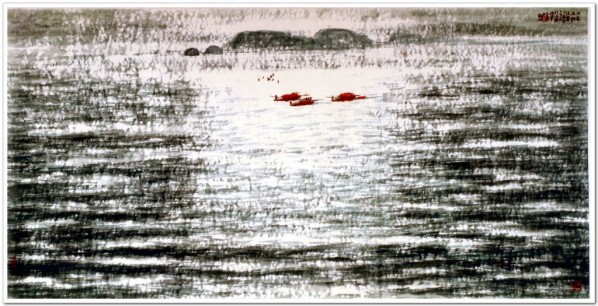
Ding Guanjia, born on Chongming Island at the Yangtze River estuary in 1937, he graduated from the Department of Fine Arts of Nanjing Normal College in 1960, learning from Fu Baoshi, Chen Zhifo, Lv Sibai, Qin Xuanfu, Huang Xianzhi, Yang Jianhou, Ya Ming and Cheng Shifa. Also he has learned calligraphy from Zhu Jia and Luo Shuzi, and he was good at landscape, calligraphy and seal cutting. He has been devoted to the creation of calligraphy and paintings and study on their history since the autumn of 1978. He had served as the vice president then president of the China National Academy of Painting in Zhenjiang for 20 years.
The works of Ding Guanjia cover both beautiful and delicate sceneries south of the Yangtze River and vigorous and natural landscape in the north. Ding Guanjia also integrates the shaping technique of Western paintings to blend Chinese and Western expressions of artistic conceptions in creation. In recent years, Ding Guanjia pursued the “image and idea” in creating landscape paintings through a continuous change of landscaping, layout and brushwork using a wrinkle method to find colors from the simplicity of ink and wash. This exhibition presents the artistic creation of Ding Guanjia over the decades, and three-dimensionally reflects the creative ideas and diversified explorations of the painter with time as the clue.
[gallery link="file" orderby="title"]
After the opening ceremony, the reporter from CAFA ART INFO interviewed renowned art theorist Shao Dazhen about his opinion on this exhibition. Shao made a comprehensive introduction to Ding Guanjia’s art, “Ding’s artistic creation has his own originality and features. Since he was born in the region south of the Yangtze River and has been working in Zhenjiang for quite a while, we can say that he has grown up by the waterside and he has a special feeling for water. The sceneries in the region south of Yangtze River are quite different from those in the north, moreover the landscapes of Zhengjiang and Congming Island differ themselves from other places in the region south of the Yangtze River. Therefore Ding has received a broad fundamental education in art at Nanjing Normal College. Cultivated by various categories of art such as oil painting, traditional Chinese painting, ink and color painting, watercolor, Ding has a comprehensive knowledge of the essentials of basic training and he draws every kind of painting. Based on that, he has a keen interest in brush and ink work and started to work on this in the middle of the 1980s. During the process of his research, he especially presents the natural landscapes of the region south of Yangtze River with wash painting. The style of his creations is different from those of Nanjing, Suzhou and Wuxi. There are two reasons for this, on the one hand, he is extremely sensitive to water; on the other hand he has a comprehensive basis of paintings, thus he integrates the methods of traditional Chinese paintings with oil painting, which makes him unique from other painters. Especially, he has creative presentations of water. His works reflect his real feelings about the innermost things as well as affections for the landscapes. His paintings have been full of intense feelings. Since he moved to the north in 2002, he has been based in Beijing. In the past decade, he has created studies on the paintings of the north and there are some characteristics of the northern paintings involved in his works including those vast grasslands at the frontier areas, which have a distinctive flavor. All in all, Ding Guanjia is a painter endowed with southern flavor who also absorbed the nutrition of the North.”
An academic seminar on Ding Guanjia’s solo show was held at the lecture hall of the National Museum of Art soon after the opening. It was chaired by Shao Dazhen and over 20 researchers including Hu Wei, Xi Jingzhi, Xue Yongnian, Ma Hongzeng, Xia Shuoqi, Wang Hongjian, Li Shusheng, Wang Yong, Li Yi, Shang Hui, Chen Jiandong, Zhao Lizhong, Liu Longting, Zhu Qingsheng, Xue Shuangxi, Zhu Hongzi and Zhang Yanzi have attended the discussions. They gave high appraisals to Ding Guanjia’s art from the perspective of his studies, living circumstances, creative ideas and achievements.
The exhibition will last until September 16th, 2012.
About the exhibition
Dates: Sep 9—16th, 2012
Venue: National Art Museum of China




























